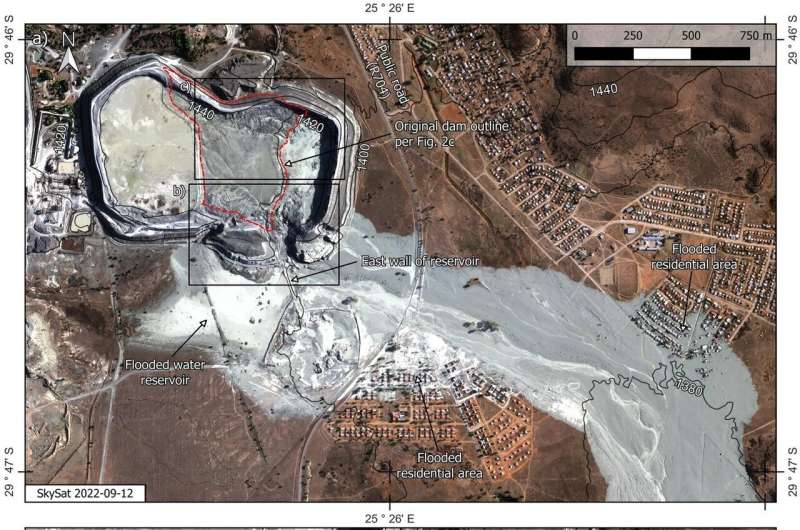This article has been reviewed according to Science X's editorial process and policies. Editors have highlighted the following attributes while ensuring the content's credibility:
fact-checked
peer-reviewed publication
trusted source
proofread
Civil engineers use public satellite images to study why the Jagersfontein dam failed

On 11 September 2022, a diamond mine waste storage facility, known as a tailings dam, failed in the town of Jagersfontein in the Free State province of South Africa. In the failure, one person was killed and multiple homes destroyed.
Tailings are the finely ground leftovers that remain after valuable metals are removed from rock ore. Tailings are generally transported jointly with water and deposited in a tailings dam for storage.
Now, six months later in 2023, civil engineers at the University of the Witwatersrand, Johannesburg (Wits), have used public satellite and aerial imagery in a study to investigate the history of the Jagersfontein dam.
Satellite images show what went wrong
Sources of public satellite images used in the study included Google Earth Pro and the Sentinel-2 and Landsat 8 satellite missions. Additionally, some of the immediate consequences of the failure were assessed using commercial satellite images.
Dr. Luis Torres-Cruz and Mr. Christopher O'Donovan in the School of Civil and Environmental Engineering at Wits authored the paper which was published in the journal Scientific Reports.
The study found that the history of the Jagersfontein dam deviates from best engineering practice. The deviations include mine waste deposition from predominantly one side of the dam, erosion gullies on the dam wall, and significant amounts of ponded water at times positioned against the retaining structure.
Based on the analyzed images, the study hypothesizes that percolation of water through the dam, followed by external erosion, ultimately triggered instability.
"We expect our paper to be useful to those interested in understanding how this tragic event came to be and also to help prevent future failures," says Torres-Cruz, corresponding author and a Senior Lecturer in the School of Civil and Environmental Engineering, who specializes in geotechnical aspects of tailings dams.
O'Donovan, study co-author and a Wits Master's candidate interested in efficient engineering practices and creating access to information, adds, "The fact that our study relies on publicly available data to investigate the history of the dam implies that anyone can independently verify our observations."
Assessment of consequences
To assess the impact and consequences of the dam failure, Torres-Cruz and O'Donovan captured two high-resolution satellite images that illustrate the damage inflicted on the surrounding residential areas.
Based on a three-dimensional reconstruction of the failed dam, the authors estimate that between four and six million cubic meters of mine waste were released.
The study also includes an animation that illustrates the post-failure geometry. Additional satellite imagery shows that the mine waste traveled 7km over dry land and 56km along streams and rivers to reach the reservoir of the Kalkfontein dam.
Outlook
The paper notes that some of the satellite imagery viewing platforms used in the analysis are free for non-commercial purposes and relatively easy to use. Accordingly, when coupled with an understanding of tailings dams, these platforms can empower stakeholders to adopt public satellite imagery as a starting point to proactively monitor tailings dams. Furthermore, the study suggests that greater awareness of the capabilities of public satellite imagery can encourage greater adherence to good construction practices.
The study also emphasizes that a robust monitoring strategy of tailings dams should focus on their adequate construction and operation. It also draws attention to the importance of conducting an official and independent site investigation to better understand the failure sequence and the conditions that led to it.
More information: Luis Alberto Torres-Cruz et al, Public remotely sensed data raise concerns about history of failed Jagersfontein dam, Scientific Reports (2023). DOI: 10.1038/s41598-023-31633-5



















